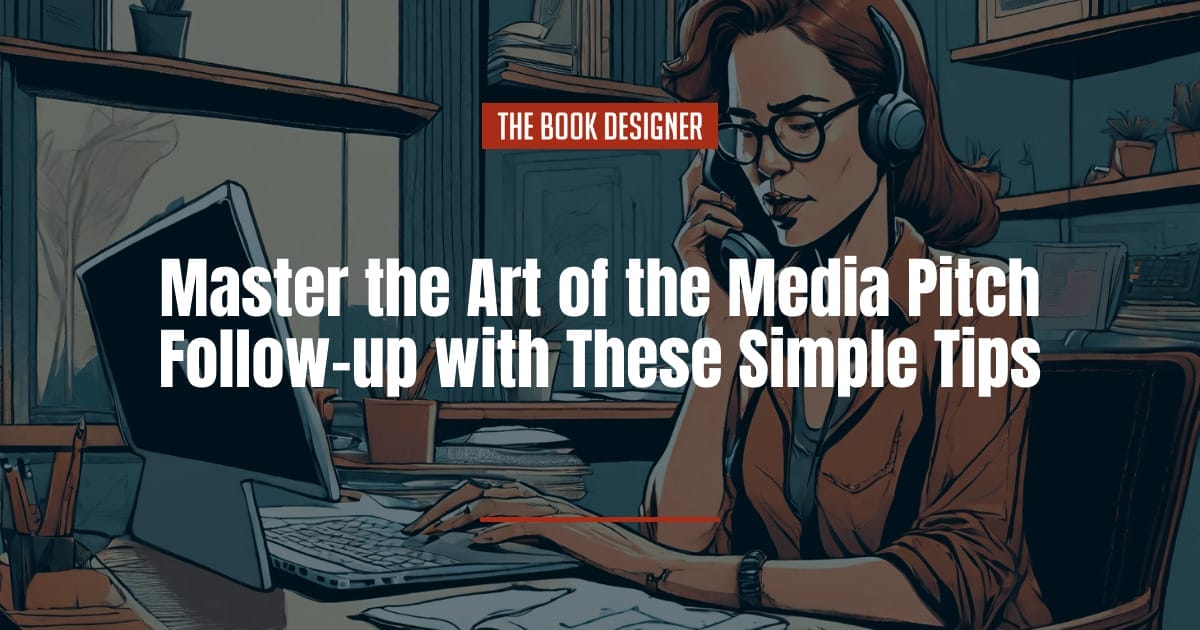You can create the most strategic and thorough book marketing and publicity plan in the world. But unless you do pitch follow-ups with all the people who you want to help you, you can kiss success goodbye.
Savvy authors commit to following up with every person they pitch including:
- journalists
- bloggers
- agents
- reviewers
- broadcasters
- bookstore owners
- retail outlets
- libraries
- book clubs
They know that spam filters can trap emails and that people can misplace phone messages. When they catch the slightest whiff that someone might be interested in publicizing, promoting or buying their books, they stay on the trail like tireless bloodhounds.
It works.
Here’s what you need to know about following up on a media pitch:
Why the Media Pitch Follow-Up is Crucial
Just ask David H. Mathews, of River Hills, Wisconsin, author of Lemons and Lemonade: My Mid-Life Dabble in Online Romance. The memoir explores the connections and disconnections he made while searching eHarmony.com for romance while in his 50s and twice divorced.
Lemons and Lemonade tells the story of his frustrating search for love, the oddball women he met along the way, and the happy ending in the last chapter titled “Clare.” After two years of dating, Mathews finally met the woman of his dreams, an artist. They started emailing, wed 39 days later, and have been married for more than 10 years.
When he published the book in fall of 2016, Mathews worked with a book publicist who pitched the media. He did all the pitch follow-up, though.
“It’s sales 101,” he says. “You make the contact. You ask for the business. If they don’t give you the business, you ask again.”
Pitch Follow-up Leads to Publicity

The best holiday for publicity about a romance book? Valentine’s Day, of course.
Mathews approached Boswell Book Company in Milwaukee, considered the best indie bookstore in Wisconsin because it has a reputation for hosting best-selling authors.
When the manager invited him to do an author reading a week before Valentine’s Day, Mathews said yes, and the store posted the event at its website.
That’s when Mathews started following up by sending emails to several journalists his publicist had pitched earlier. They included Jim Stingl, a popular columnist with the Milwaukee Journal Sentinel, and Kathy Mykleby, a longtime anchor at the local ABC station in Milwaukee.
“Jim and I hit it off immediately,” Mathews said. The story appeared in the Sunday edition a few days before the book signing, and online—the perfect springboard from which to pitch the TV anchor. “I embedded my bookstore event notification in the email I sent to Kathy to indicate I already had something going.”
She and a camera crew interviewed him at his home. The two-and-a-half-minute segment on Mathews and his experiences with online dating included video clips from the book reading at the bookstore. He embedded links to the newspaper and TV stories into other email pitches to bookstores and venues where he can speak. And, of course, he followed up.
Mathews maintains there’s no low-hanging fruit with this type of publicity campaign and that success requires diligent follow-up. “If you want any fruit, you’ve got to use the ladder.”
Tips for Following Up
Most journalists say, “We don’t want follow-ups.” What they really mean is, “We don’t want crappy follow-ups that waste our time” like this: “I’m just following up to see if you received my press release three weeks ago and if you know when it will be printed.”
That pitch assumes reporters will drop everything, hunt for the release and take time to see if it’s been printed. They won’t, so don’t bothering following up a press release. I worked as a newspaper reporter and editor for 22 years. We branded those people who called us “first-class pests.”
Follow up email or phone pitches to the media only once, unless the person you’re pitching has expressed an interest in your idea but hasn’t said yes. If the journalist is still interested but hasn’t committed, keep following up every few weeks until you hear “no.”
If you hear, ”No, not now,” ask if you can follow up later.
An ideal follow-up serves as a reminder that you already sent information but that – this part is important – you’re offering something else that’s related.
12 Other Things You Can Offer
You can offer any type of “extra” that helps round out the story. Here’s a dozen of my favorites:
- New information like new statistics you found from a study that ties into the topic of your pitch
- More details
- Access to other sources, with contact information. Make sure the sources will agree to be interviewed and that they know which media outlets you’re pitching so they aren’t surprised when a reporter calls.
- A how-to video or a video series
- Photos
- A podcast segment on the same topic
- A slideshow, perfect for explaining step-by-step directions
- Graphics (infographic, map, pie chart, bar chart)
- A tutorial
- A quiz
- A White Paper
- Illustrations if you own the copyright
Anatomy of a Perfect Follow-up
When following up by email, forward the original email you sent and use the same subject line followed by double dashes and “new information” or “more information,” like this:
Subject Line:
Story Idea: How kids can save money – new informationHi Rob,
I introduced myself to you on Oct. 15 and invited you to call on me if you need a source on personal finance for children. (I’ve included the original email below.)
Just wanted to let you know that I can also offer a slick infographic from my book, “Cool Kids Save Money.” It includes 15 creative jobs kids can do around the neighborhood to make money fast. I own the copyright and you may use the tips however you wish. Let me know if you’d like to see it and if I may send it as an attachment.
Peter
(The original email appears here.)
How to Follow up a Book Review Request
If someone asks for a copy of your book to review but you haven’t seen a review, send the follow-up as part of the same email chain to remind them that they asked for it. It makes them feel that they owe you a response.
If you’re an introvert, like most authors, and the thought of following up scares you, think of all the things that have fallen through the cracks on your end. Then think how good you felt when someone followed up with you and reminded you of something important that you missed.
I also love this quote from Bill Bradley, the basketball-player-turned politician:
“Ambition is the path to success. Persistence is the vehicle you arrive in.”



